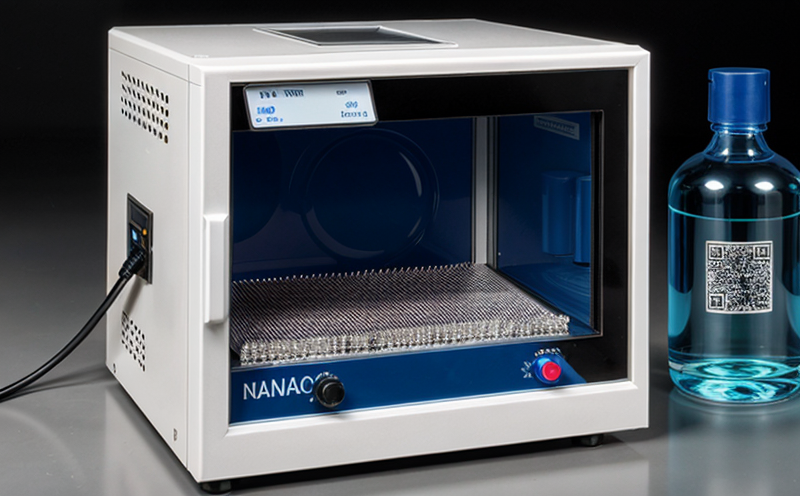EN 17359 Chemical Safety Testing of Nanomaterials in Food Contact
The European Standard EN 17359 provides a robust framework for assessing the chemical safety of nanomaterials used in food contact applications. This service is essential for ensuring that nanochemical compounds do not contaminate or degrade food products, thereby safeguarding consumer health and compliance with regulatory requirements.
The growing use of nanotechnology in the food industry has necessitated stringent testing protocols to evaluate potential risks associated with these materials. The standard focuses on identifying chemical substances that could leach from nanostructured surfaces into foodstuffs during processing or consumption. Compliance with EN 17359 is critical for manufacturers aiming to introduce innovative products while adhering to stringent safety standards.
Our laboratory employs advanced analytical techniques tailored specifically for nanomaterial analysis, including scanning electron microscopy (SEM), transmission electron microscopy (TEM), and inductively coupled plasma mass spectrometry (ICP-MS). These methods allow us to characterize the physical properties of nanomaterials at atomic resolution levels. Additionally, we utilize liquid chromatography tandem mass spectrometry (LC-MS/MS) for detecting trace amounts of potentially hazardous chemicals.
Specimen preparation plays a crucial role in obtaining accurate results under EN 17359 guidelines. Samples must be representative of the actual product being tested to ensure reliable outcomes. This involves careful selection and processing of materials, followed by thorough cleaning procedures to eliminate contaminants that might interfere with analytical measurements. Our experienced technicians possess extensive knowledge in handling nanomaterials safely and accurately.
The testing process typically includes several stages designed to assess different aspects of chemical safety:
- Initial characterization: Determination of particle size distribution, shape, and concentration.
- Exposure simulation: Reproduction of real-world conditions where nanomaterials come into contact with foodstuffs.
- Leaching analysis: Measurement of any chemical compounds released from the nanomaterial during exposure.
- Safety evaluation: Interpretation of data to determine whether the detected chemicals pose a risk to human health.
Our team utilizes internationally recognized standards such as ISO, ASTM, EN, and IEC throughout our testing procedures. By adhering strictly to these guidelines, we ensure consistent and accurate results that meet global regulatory expectations.
The importance of this service cannot be overstated, especially given the increasing popularity of nanotechnology in various sectors including food packaging, cosmetics, pharmaceuticals, and more recently, biodegradable plastics. Ensuring chemical safety not only protects consumers but also enhances brand reputation by demonstrating commitment to responsible innovation practices.
Scope and Methodology
| Stage of Testing | Description |
|---|---|
| Initial Characterization | Determination of particle size distribution, shape, and concentration using SEM and TEM. |
| Exposure Simulation | Reproduction of real-world conditions where nanomaterials come into contact with foodstuffs. |
| Leaching Analysis | Measurement of any chemical compounds released from the nanomaterial during exposure. |
| Safety Evaluation | Interpretation of data to determine whether the detected chemicals pose a risk to human health. |
The scope encompasses comprehensive evaluation of nanomaterials' chemical stability and potential for migration into food contact surfaces. Our methodology ensures that all tests are conducted according to the latest EN 17359 specifications, providing clients with confidence in their product's safety.
Quality and Reliability Assurance
We prioritize quality assurance through rigorous internal audits and external certifications. All staff members undergo continuous training to stay updated on industry advancements and best practices. Our facilities are equipped with state-of-the-art equipment, ensuring precise measurements and accurate results.
To further enhance reliability, we implement strict quality control measures at every stage of the testing process. This includes regular calibration of instruments, documentation of all procedures followed, and review by independent reviewers who verify compliance with EN 17359 requirements.
Client satisfaction is paramount to us. Therefore, we offer detailed reports outlining our findings along with recommendations for improving product safety if necessary. These reports are tailored specifically for your organization's needs, making them easy to understand even for non-technical personnel involved in decision-making processes regarding new product development or existing product modifications.
International Acceptance and Recognition
- EN 17359 has gained widespread acceptance across Europe as the primary standard for assessing nanomaterials used in food contact applications.
- The United States Food and Drug Administration (FDA) also recognizes this standard, encouraging its use by manufacturers seeking approval for novel products containing nanotechnology elements.
- Japan's Ministry of Health, Labor, and Welfare has endorsed EN 17359 as a guideline for ensuring the safety of nanochemicals in food contact materials.
- The World Health Organization (WHO) recommends adherence to this standard when developing international guidelines related to nanomaterials in food packaging.
By participating in this service, you contribute towards maintaining high standards globally, which is crucial for fostering trust among consumers worldwide.





